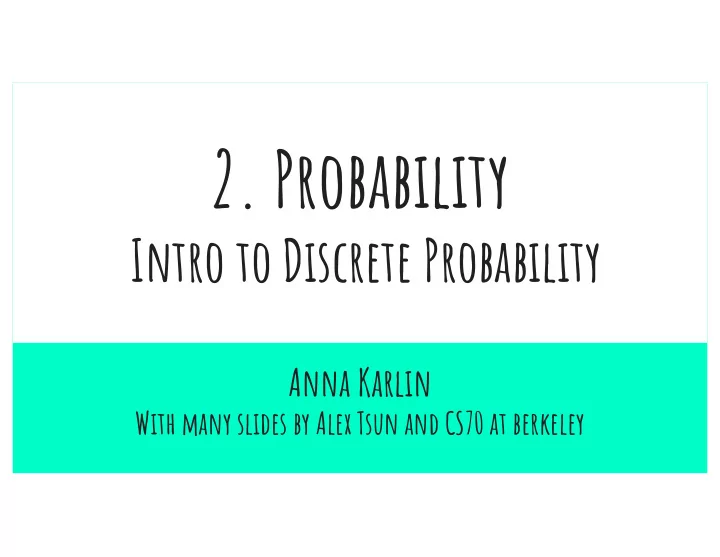

2. Probability Intro to Discrete Probability Anna Karlin With many slides by Alex Tsun and CS70 at berkeley
Agenda ● Definitions ● Axioms ● Equally Likely Outcomes ● Beyond equally likely outcomes ● Conditional Probability
Definitions
Definitions
Definitions
Example:weird dice (Sample Space) Suppose i roll two 4-sided dice. Here is the sample space (set of possible outcomes) Die 2 (red) 1 2 3 4 1 (1, 1) (1, 2) (1, 3) (1, 4) 2 (2, 1) (2, 2) (2, 3) (2, 4) Die 1 (blue) 3 (3, 1) (3, 2) (3, 3) (3, 4) 4 (4, 1) (4, 2) (4, 3) (4, 4)
Example:weird dice (Events) Let D1 be the value of the blue die, and D2 the value of the red die. What outcomes match these events? Die 2 (red) A. D1 = 1 1 2 3 4 B. D1 + D2 = 6 1 (1, 1) (1, 2) (1, 3) (1, 4) C. D1 = 2 * D2 2 (2, 1) (2, 2) (2, 3) (2, 4) Die 1 (blue) 3 (3, 1) (3, 2) (3, 3) (3, 4) 4 (4, 1) (4, 2) (4, 3) (4, 4)
Example:weird dice (Events) Are A and B mutually exclusive? Are B And C mutually exclusive? Die 2 (red) A. D1 = 1 1 2 3 4 B. D1 + D2 = 6 A A A A 1 (1, 1) (1, 2) (1, 3) (1, 4) C. D1 = 2 * D2 2 (2, 1) (2, 2) (2, 3) (2, 4) B C Die 1 (blue) B 3 (3, 1) (3, 2) (3, 3) (3, 4) 4 (4, 1) (4, 2) B (4, 3) (4, 4) C
Example:weird dice (mutually exclusive) Are A and B mutually exclusive? YES. A ∩ B = ∅ (no overlap) Die 2 (red) 1 2 3 4 A A A A 1 (1, 1) (1, 2) (1, 3) (1, 4) 2 (2, 1) (2, 2) (2, 3) (2, 4) B C Die 1 (blue) B 3 (3, 1) (3, 2) (3, 3) (3, 4) 4 (4, 1) (4, 2) B (4, 3) (4, 4) C
Example:weird dice (mutually exclusive) Are B And C mutually exclusive? NO. B and C could happen at the Die 2 (red) same time (4, 2) 1 2 3 4 A A A A 1 (1, 1) (1, 2) (1, 3) (1, 4) 2 (2, 1) (2, 2) (2, 3) (2, 4) B C Die 1 (blue) B 3 (3, 1) (3, 2) (3, 3) (3, 4) 4 (4, 1) (4, 2) B (4, 3) (4, 4) C
Random Picture
Axioms of Probability & Their Consequences E F
Axioms of Probability & Their Consequences E C E
Axioms of Probability & Their Consequences F E
Axioms of Probability & Their Consequences
Example:weird dice (Events) Think back to the 4-sided dice. Suppose each die is fair. Intuitively, What is the probability that the Die 2 (red) Two dice sum to 6? (D1 + D2 = 6) 1 2 3 4 1 (1, 1) (1, 2) (1, 3) (1, 4) 2 (2, 1) (2, 2) (2, 3) (2, 4) Die 1 (blue) 3 (3, 1) (3, 2) (3, 3) (3, 4) 4 (4, 1) (4, 2) (4, 3) (4, 4)
Example:weird dice (Events) Think back to the 4-sided dice. Suppose each die is fair. Intuitively, What is the probability that the Die 2 (red) Two dice sum to 6? (D1 + D2 = 6) 1 2 3 4 1 (1, 1) (1, 2) (1, 3) (1, 4) Each of the 16 outcomes is 2 (2, 1) (2, 2) (2, 3) (2, 4) B Equally likely. Die 1 (blue) B 3 (3, 1) (3, 2) (3, 3) (3, 4) 3/16. 4 (4, 1) (4, 2) B (4, 3) (4, 4)
Equally Likely Outcomes
Coin tossing Toss a coin 100 times. Each outcome is equally likely. What is the probability of seeing 50 heads?
Non-equally Likely outcomes
More examples – uniform probability spaces
Nonuniform probability spaces
Axioms of Probability & Their Consequences
Probability Alex Tsun Joshua Fan
Conditional Probability slides mostly by Alex Tsun
Conditional Probability (idea) 36 7 13 14 What’s the probability that someone likes ice cream given they like donuts?
Conditional Probability (idea) 36 7 13 14 What’s the probability that someone likes ice cream given they like donuts?
Conditional Probability
Conditional Probability (Reversal)
Conditional Probability (intuition)
Fun with conditional probability ● Toss a red die and a blue die. All outcomes equally likely. What is Pr(B | A)? What is Pr(B)?
Fun with conditional probability ● Toss a red die and a blue die. All outcomes equally likely. What is Pr(B | A)?
33 Gambler’s fallacy ● Flip a fair coin 51 times. All outcomes equally likely. ● A = “first 50 flips are heads” B = “the 51 st flip is heads” ● ● Pr (B | A) = ?
Recommend
More recommend